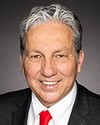Thank you. Tansi. Ulaakut. Hello. Bonjour.
Thank you for inviting me here today.
I look forward to providing further insight into my and our government's priorities regarding the north. My office and the department are always working alongside Arctic and northern partners to address local priorities and help them in having the resources to respond to their communities' needs. Our work is guided by the Arctic and northern policy framework.
I don't need to tell anyone here that one of the most significant challenges in the north is food security. On that, we're working with northern and indigenous partners, through the nutrition north Canada program, to make healthy food more affordable in the north. By subsidizing food and everyday items such as diapers, soap and personal hygiene products, the program has helped lower the costs of some items by as much as 76%. For example, in July this year, in Sachs Harbour in NWT, the cost of a five-kilogram bag of flour would be more than $42 without the subsidy. It's now $4.89, a huge difference for families and the community. There are examples like this in all 124 communities that fall under nutrition north.
We are also responding to food security in the north by adding $23 million to the subsidy itself and over $100 million in two other important programs: the harvesters support grant, which supports traditional hunting, harvesting and food sharing; and the community food programs fund, which supports community food-sharing initiatives. Since 2020 there were more than 15,000 harvests, with over 700 new food-sharing initiatives and 410 hunts and harvests taking place.
Another priority is narrowing the northern housing and infrastructure gap. Our government is working collaboratively to help increase the region's housing stock, reduce overcrowding and homelessness, improve housing conditions and assist communities with their specific needs. We're doing this through investments for self-determined housing and infrastructure development. This includes, of course, $4.3 billion announced to co-develop and launch an urban, rural and northern indigenous housing strategy with, of course, indigenous partners. We know that self-determined, distinctions-based investments are working. As examples, since 2016, Inuit treaty organizations constructed over 650 new housing units, repaired over 469 existing units and developed land in their communities for new housing.
The north faces other significant challenges. The region is warming at four times the global average, with far-reaching consequences for people who live there, for wildlife and, of course, for the environment. We're working with indigenous and northern communities to address the effects of climate change, to help advance indigenous climate leadership and to shift to renewable sources of energy. Programs, such as the climate change preparedness in the north program, are helping to develop northern-led solutions to deal with coastal erosion, permafrost degradation and increased floods and wildfires.
All in all, food security, housing and climate change are three of the top priorities of the government that my department is addressing in the north and in the Arctic. Just a few weeks ago in Iqaluit, Premier P.J. Akeeagok and I co-hosted an Arctic and northern policy framework leadership committee meeting, where we announced a new approach to helping improve the nutrition north program. Starting this year we will be appointing a ministerial special representative to conduct an external review, and chairing a research symposium with indigenous partners to discuss key findings.
To end, Mr. Chair, there are many pressing issues facing the north and the Arctic, and that's also true for indigenous peoples across the north and the Arctic. Our government is working hard with partners to deliver results on these long-standing issues.
I look forward to your questions, and it's great to be here. Thank you very much. .

